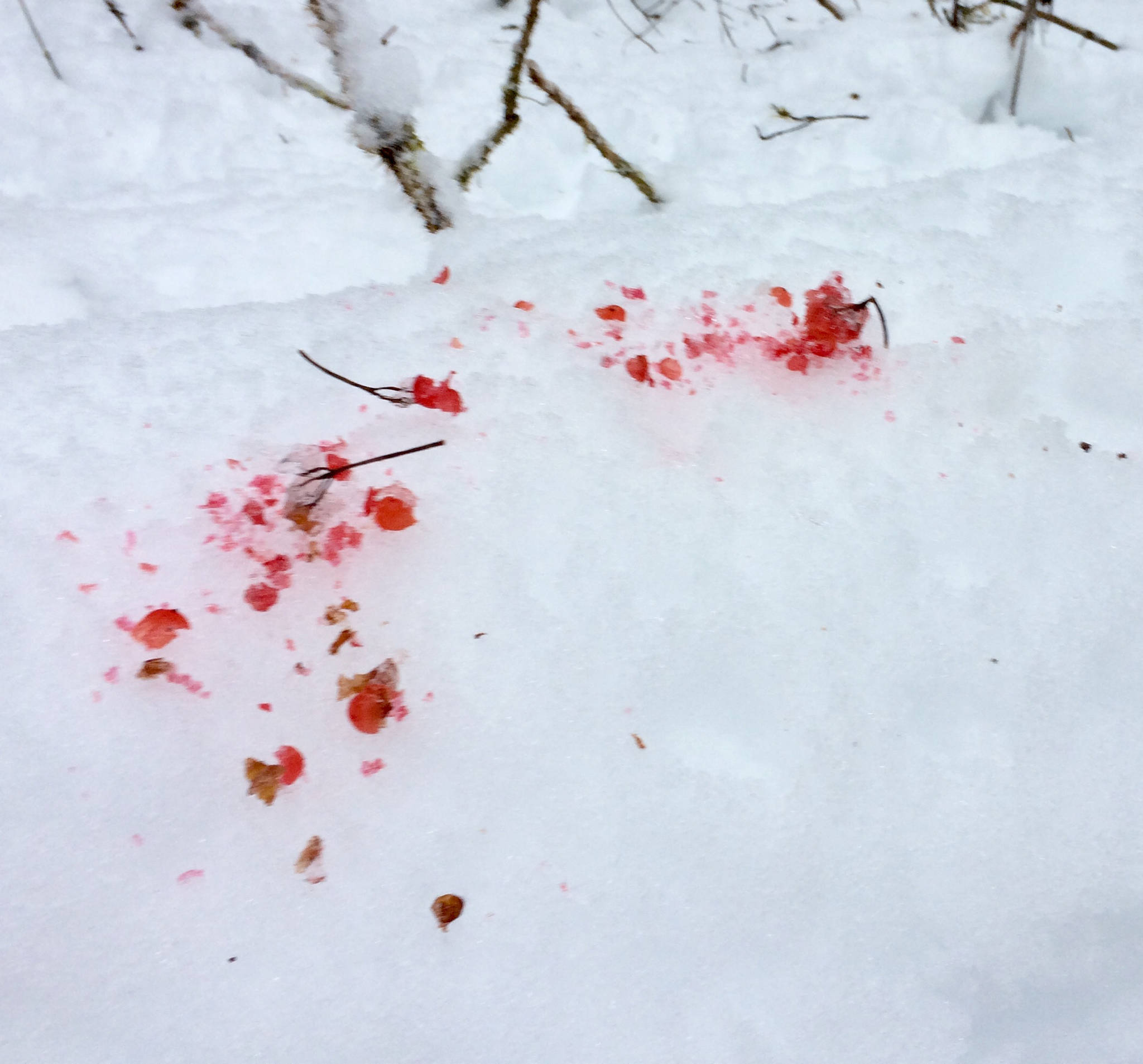A hard crust on top of deep snow made it exhausting to go off-trail very far. Even with snowshoes, the post-holing was hard going. So our forays weren’t very long. Nevertheless, the curious naturalists found several things of interest.
There was still some open water in the sloughs, so crossing them was dicey, and we diverted to the Moraine Ecology Trail, which was partially packed down by previous walkers. Here, we noticed new spiderwebs laced across recent footprints and other divots. Even though we did not see the owners of the webs, it was clear that they can be active in cold weather. In addition to these web-builders, we sometimes see jumping spiders huddled on top of snow. Spiders are out and about, but what can they hope to capture and eat?
[Tracking animal footprints in the snow]
The next day, after much dithering about where to walk, we ended up on the first part of the well-packed trail along Eagle River. This turned out to be quite productive for us.
The first thing that captured our fancy was a snowy, suspended log that supported a few blueberry bushes and at least four stands of the now-dead-and-brown flowering shoots of northern ground cone. This plant has no green leaves, so it cannot photosynthesize carbohydrates for itself. It is totally parasitic, mostly on alder, but occasionally on other species, perhaps blueberry in this case.
Presently, we began to see red — fragments of highbush cranberries in numerous, widespread patches on top of snow-covered logs and hummocks. There were a few whole berries, but in nearly all cases the seeds had been extracted, leaving bits of red pulp and fruit skins. Aha! Pine grosbeaks had been at work! Part of their scientific name reflects this behavior: “enucleator” meaning seed (or nut) extractor, although they also eat many other kinds of seeds, buds and insects. They typically nest in open conifer forests of boreal North America and Eurasia; here, in fall and winter, at least, they regularly enucleate highbush cranberries.
We conjectured that the birds found it hard to handle the frozen fruits while perched in the shrubs (in warmer weather, they commonly process the fruit while perched) and brought them down to the snow. There they may have been able to brace each berry on the hard surface while biting it, or maybe they could use the snow as an anvil for striking it. Since the berries grown in clusters, by yanking on one, the birds may have incidentally brought down a few more, some of which were not opened (but why not?).
[Wild Shots: Photos of Mother Nature in Alaska]
A bit later, we came upon an active red squirrel residence, with three entrances less than a meter a part. Outside of one doorway was a scattering of black, dried-up devil’s club berries, mostly with the seeds removed. There were also two very bedraggled spruce cones that looked like they’d spent too long in the underground cache. On both old cones, the squirrel had removed only the basal two rows of cone scales. Spruce cones usually bear seeds on the scales of the lower half (or so) of the cone and not at the tip, but these cones apparently did not have a full complement of good seeds.
On our way out, my companion heard a woodpecker, so of course we stopped to look. About 30 feet up a narrow spruce tree, the bird was at work, tapping the trunk and flaking off bark scales. It was hard to get a good look at it — woodpeckers often seem to go to the back side of a tree, keeping the trunk between them and us. But eventually, this bird came around far enough that we could see its all-black back, no white showing at all. Oh good! A black-backed woodpecker, which is quite a rare species in our area (and I got lucky a few years ago in Gustavus, which I found a nest of this species just at the time that the chicks were fledging).
This woodpecker forages mostly on dead and dying trees in coniferous forest, often after a forest fire. They eat a lot of wood-boring beetles, extracted by hammering holes in the wood. They have stronger hammering power than most other woodpeckers. They stand farther from the tree trunk and use the whole body to pound a hole. Unlike most other woodpeckers, they have only three toes on each foot — there is no hind toe. Ornithologists speculate that somehow the lack of the hind toes facilitates the heavy-duty pounding.
• Mary F. Willson is a retired professor of ecology. “On The Trails” is a weekly column that appears every Friday. Her essays can be found online at onthetrailsjuneau.wordpress.com.

